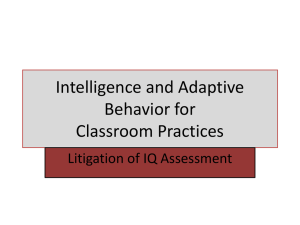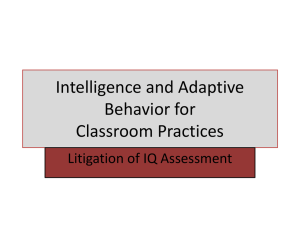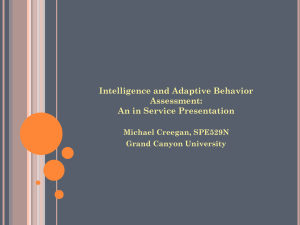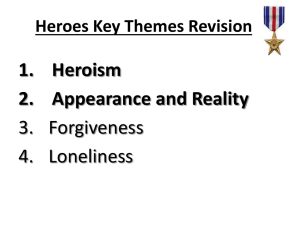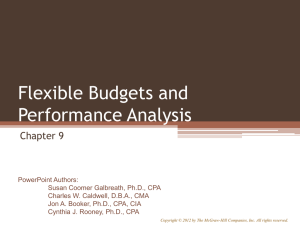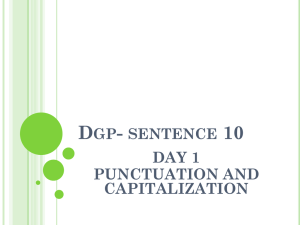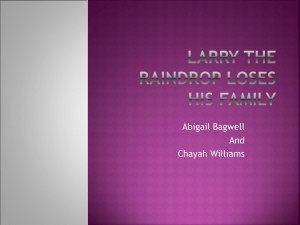Chapter 5
advertisement
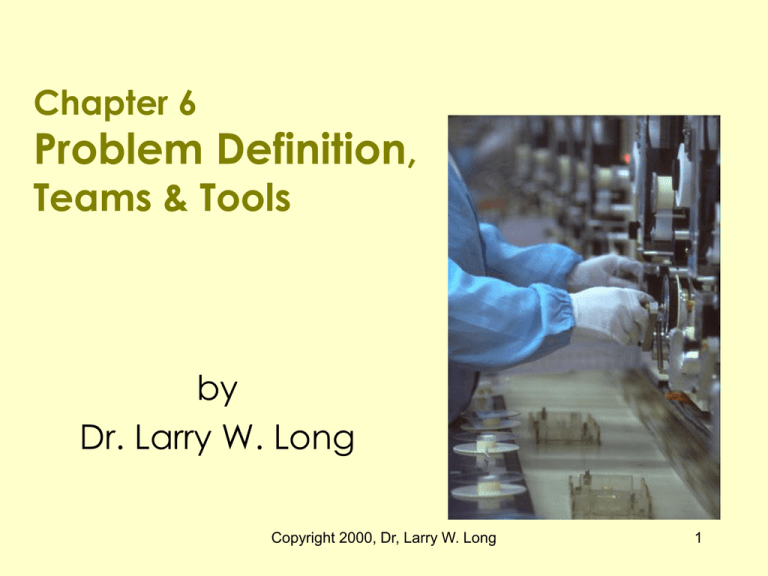
Chapter 6 Problem Definition, Teams & Tools by Dr. Larry W. Long Copyright 2000, Dr, Larry W. Long 1 Problem Definition Models • • • • • • • • • Reflective thinking Koehler’s RPIM Koehler’s PAIM Brainstorming Synectics Intertia Activation Larson’s Questions Hierarchical Elaborated Hierarchical Copyright 2000, Dr, Larry W. Long 2 Dewey’s Reflective Thinking • Problem-solving – – – – – – experience difficulty isolate and define difficulty suggest possible solutions examine solutions choose solution / implement evaluate situation Copyright 2000, Dr, Larry W. Long 3 Dewey’s Reflective Thinking • Assumption: – All information is available • Strength: – Logical, time-tested approach • Weakness: – Assumes everyone has access to all information necessary to define and solve problem Copyright 2000, Dr, Larry W. Long 4 Koehler’s RPIM-Model • Reactive Problem Identification - Model • A Cause and Effect Strategy – Identify undesirable condition – Identify cause of condition – Identify ways to remove or alter the cause Copyright 2000, Dr, Larry W. Long 5 Koehler’s RPIM-Model • Define desirable outcomes • Describe what occurred • Explore effects • Identify negative effects • Define cause of negative effects Copyright 2000, Dr, Larry W. Long 6 Koehler’s RPIM-Model • Assumption: – Identify cause, remove cause, solve problem • Strength: – Identifies negative effects; enables specific action • Weakness: – Problems rarely have one cause Copyright 2000, Dr, Larry W. Long 7 Koehler’s PAIM or Goal Achievement • ProActive problem Identification - Model • Three Questions: – What is the goal or object – What blocks goal achievement – How can the barriers be removed Copyright 2000, Dr, Larry W. Long 8 Koehler’s PAIM • Assumption: – Assumes barriers to goals are problems that need to be identified and removed • Weakness: – Requires clear, mutual, understanding of long and short-term goals Copyright 2000, Dr, Larry W. Long 9 Brainstorming • Free expression without evaluation • Everyone participates fully • Evaluation begins after all ideas are expressed Copyright 2000, Dr, Larry W. Long 10 Brainstorming • Assumption: – An open environment creates high quality solutions • Strength: – Multi-purpose approach – High-quality decisions – Encourages creativity • Weakness: – Time-consuming and vague – Norms can impede creative ideas Copyright 2000, Dr, Larry W. Long 11 Synectics Strategies • Begin with solutions – Identify solutions by Fantasizing – Evaluate solutions – Repeat fantasize evaluation sequence – Develop consensus Copyright 2000, Dr, Larry W. Long 12 Synectics Strategies • Assumption: – Employees are obstacles to identifying problems and solutions • Strength: – Freedom to generate creative solutions • Weakness: – Dependent on worker’s ability to be uninhibited and on support of the organization Copyright 2000, Dr, Larry W. Long 13 Inertia-Activation Strategies • Group with the same values or opposite values • Activate their values • Frustration, inertia, release of energy Copyright 2000, Dr, Larry W. Long 14 Inertia-Activation Strategies • Assumption: – Forced inertia results in activity; produces results • Strength: – Problem/solution identified readily and effectively • Weakness: – People become anxious and uncomfortable Copyright 2000, Dr, Larry W. Long 15 Larson’s Single Questions • What is the problem • Subdivide question into sub-questions • Gather information; assess solutions • Similar to outlining speech Copyright 2000, Dr, Larry W. Long 16 Hierarchical Strategies • Structure the problem into parts or chunks • Order from most to least important • Select solution that matches importance of the problem Copyright 2000, Dr, Larry W. Long 17 Hierarchical Strategies • Assumption: – Assumes there are degrees of information • Strength: – Recognizes the complexity of organizational problems – Provides equal emphasis on selecting solution • Weakness: – Problems are often too complex for one simple solution Copyright 2000, Dr, Larry W. Long 18 Elaborated Hierarchical Identify Problem • • • • • Locate Context Order Subproblem Identify Solutions Assess Consequences Chunk problem / identify complexity Intraorganizational vs. interorganizational Internal vs. external / work vs. person Determine and rank solutions Solutions often create new problems Copyright 2000, Dr, Larry W. Long 19 Elaborated Hierarchical • Assumption: – Problems consists of multiple, overlapping causes • Strength: – Systematic attempt to subdivide and prioritize problems – Defines problem more completely • Weakness: – Complex process requiring time and skilled personal Copyright 2000, Dr, Larry W. Long 20 PSID Models & Complexity • • • • • • • Most complex Elaborated hierarchial Hierarchical Inertia-activation Synectics Brainstorming Goal achievement - PAIM Cause-Effect - RPIM Least Complex Copyright 2000, Dr, Larry W. Long 21 Using teams • • • • • Team vs. committee When to use teams Team advantages Team purpose Team composition Copyright 2000, Dr, Larry W. Long 22 Team vs. committee • • • • • • size (6 to 8) vs. larger group not necessarily representative vs. representative consensus vs. directed or majority rule responsible for outcome vs. advisory use of tools vs. dialogue use of data vs. conjecture Copyright 2000, Dr, Larry W. Long 23 When is a TEAM needed? Sponsor has identified a critical process to be improved Desirable to enhance productive efficiency Desirable to maximize PARTICIPANT satisfaction Desirable to gain participant “buy-in!” Copyright 2000, Dr, Larry W. Long 24 TEAM advantages Reduces job role isolation Process vs. individual action Focus on team vs. individual rewards Reduces interpersonal competition & enhances cooperation Overcomes vested interests Identifies process bottlenecks Copyright 2000, Dr, Larry W. Long 25 TEAM Purpose Improve effectiveness & efficiency of process, by acquisition, transformation, disposal of physical, capital, human, information resources to benefit all participants input throughput Copyright 2000, Dr, Larry W. Long output 26 Who should be in a PAT? Non-management and management employees who are experienced, expert in the process Suppliers (input providers) Customers (output users) Process operators (input transformers) Facilitator (objective 3rd party) Copyright 2000, Dr, Larry W. Long 27 Team Decision Tools – purpose & application (derived from Brassard & Ritter, Fisher, Cragan & Wright) Copyright 2000, Dr, Larry W. Long 28 Decision Tools – Typical Flow (MJII) Flowchart Brainstorming Interrelationship Digraph Aspect Grouping Fishbone Task & Objective Plan Copyright 2000, Dr, Larry W. Long 29 Facilitation Tools & Uses FLOWCHART Map the process BRAINSTORMING Discover ideas ASPECT Grouping Group ideas INTERRELATIONSHIP Find main influence FISHBONE Identify causes Task & Objective Plan Map/implement Copyright 2000, Dr, Larry W. Long 30 Flowcharting 1. Define boundaries 2. List steps (brainstorm) 3. Sequence steps Input/begin (materials, information or action) Task or Activity #1 Decision Task or Activity #2 Copyright 2000, Dr, Larry W. Long Task or Activity #3 Output/End 31 Brainstorming 1. State issue 2. Write down ideas and display 3. Review/generate more ideas T1 T2 T3 T6 T7 T10 T5 T4 T11 T9 T8 Copyright 2000, Dr, Larry W. Long 32 Aspect Grouping 1. Phrase issue in a full sentence 2. Simultaneously sort all ideas into related groupings 3. Assign aspect label for each group Issue Aspect 1 Aspect 2 T1 T6 T5 T8 Copyright 2000, Dr, Larry W. Long 33 Interrelationship Digraph 1. List aspects from aspect grouping session 2. For each possible pair (#aspects-1) determine A4 which primarily I = 2.5 influences outcomes O =.5 from the other 3. Tally outgoing and incoming arrows for each issue to determine primary influencers Copyright 2000, Dr, Larry W. Long A1 I=0 O= 3 A2 I=1 O=2 A3 I = 2.5 O =.5 34 Fish Bone 1. Select main influencer from interrelationship digraph, then brainstorm & aspect group to -2. Generate main causes 3. Generate sub-causes 4. Sub-sub causes, etc. Copyright 2000, Dr, Larry W. Long #1 Influence 35 Task & objective plan 1. Based on digraph/fishbone outcomes, write goal; determine completion date 2. List measurable objectives required to reach goal 3. Brainstorm actions needed to achieve each objective -- break each into steps 4. Determine time needed to do step 5. Develop schedule 6. Implement & monitor GOAL (to be completed by . . .) OBJ 1 20 days S1a S1b S2a S2b OBJ 2 90 days S1c OBJ 3 60 days S1d S1d S2c S3a Copyright 2000, Dr, Larry W. Long 36

